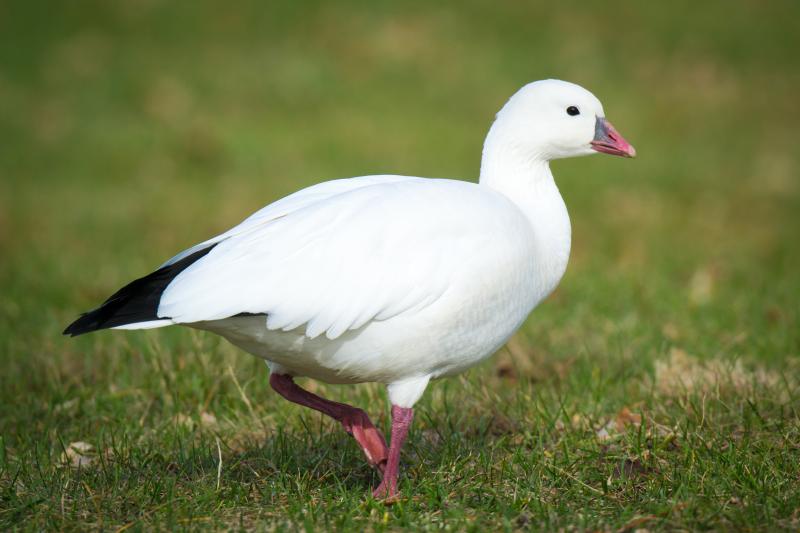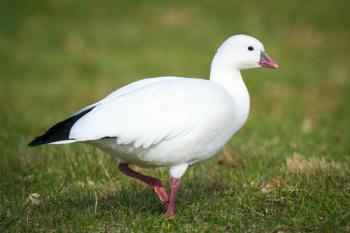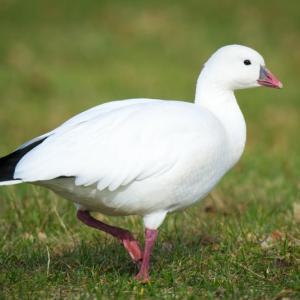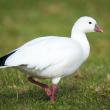A Holiday Goose
 Ross's goose is a small look-alike to the snow goose. Numbers were once perilously low and the wintering grounds were confined to California. In the last 50 years, the numbers have rapidly increased into the millions. Maine registered its eight record in November. Photo by Andrew C courtesy of Wikimedia Commons.
Ross's goose is a small look-alike to the snow goose. Numbers were once perilously low and the wintering grounds were confined to California. In the last 50 years, the numbers have rapidly increased into the millions. Maine registered its eight record in November. Photo by Andrew C courtesy of Wikimedia Commons.
 Ross's goose is a small look-alike to the snow goose. Numbers were once perilously low and the wintering grounds were confined to California. In the last 50 years, the numbers have rapidly increased into the millions. Maine registered its eight record in November. Photo by Andrew C courtesy of Wikimedia Commons.
Ross's goose is a small look-alike to the snow goose. Numbers were once perilously low and the wintering grounds were confined to California. In the last 50 years, the numbers have rapidly increased into the millions. Maine registered its eight record in November. Photo by Andrew C courtesy of Wikimedia Commons.
A Ross’s goose was found last week in Bangor, hanging out in a cornfield with at least one snow goose. Unfortunately for us, we have not been able to carve out the time to drive up and see this rare bird, and it’s a species we’ve yet to see here in Maine. We have seen Ross’s goose in other places, the most memorable of which was in Ithaca, New York, (home of the famed Cornell Lab of Ornithology) in March, 1990. Until then, there were no previous records of the species in that area despite the many birders associated with Cornell (meaning, birders who are enjoy common species but are always keenly on the lookout for the next rare bird) and so it was especially exciting to be the discoverer, on a morning survey of the birds at the south end of Cayuga Lake.
The Ross’s goose is a small look-alike of the snow goose. Both (in their white phase, at least) are all white with black wing tips and pink bill and legs. The snow goose, though significantly smaller than the Canada goose, is larger than the Ross’s goose, with a thicker bill that shows an obvious black line (typically called a “grinning patch”) between the upper and lower mandibles. In Ross’s goose, this black “grinning patch” is lacking or very reduced.
Ross’s goose was once an exceedingly rare species, down to fewer than 10,000 in the 1950s, with their entire wintering population confined to the Sacramento Valley of California and the breeding population found in the Central Arctic. Various efforts were made to lower hunting mortality for the species during migration and on its wintering grounds. This, and then later, the changes to agricultural harvesting methods that left more waste corn and grains in the fields, helped more Ross’s geese and snow geese to survive. Populations of both species rapidly increased, and Ross’s goose numbers are now in the low millions, with snow goose numbers perhaps twice as high.
Interestingly, the high numbers of snow geese and Ross’s geese have been causing problems on the Arctic and sub-Arctic breeding grounds because the birds at many locations have been essentially destroying the salt marsh habitat, as such large numbers dig around for the roots of the plants and turn the marsh into mudflats.
As the numbers of Ross’s goose have increased, their wintering range has expanded and there have been more and more sightings of the species across the continent. Here in Maine, the first recorded Ross’s goose was in April, 2002. There have been at least eight more records since then, counting the bird in Bangor last week. These birds may be coming from breeding populations that have expanded along the coasts of Hudson Bay and James Bay.
Ross’s goose was so named by an early ornithologist in 1861, for a naturalist named Bernard Ross who worked for the Hudson Bay Company in various locations in what is now Manitoba and the Northwest Territories. Ross sent bird specimens he collected to the Smithsonian, including what was apparently the first whole specimen of the little goose. Another explorer had actually described the bird in the 1700s but had eaten rather than preserved the birds he collected. Of course, the Indigenous people of the region certainly knew and named the birds in their languages well before Europeans first laid eyes on them.
If the Ross’s goose in Bangor decides to stay around a bit longer, perhaps we will be treated to a new Maine goose for the holidays.
Jeffrey V. Wells, Ph.D., is a Fellow of the Cornell Lab of Ornithology and Vice President of Boreal Conservation for National Audubon. Dr. Wells is one of the nation's leading bird experts and conservation biologists and author of the “Birder’s Conservation Handbook.” His grandfather, the late John Chase, was a columnist for the Boothbay Register for many years. Allison Childs Wells, formerly of the Cornell Lab of Ornithology, is a senior director at the Natural Resources Council of Maine, a nonprofit membership organization working statewide to protect the nature of Maine. Both are widely published natural history writers and are the authors of the popular books, “Maine’s Favorite Birds” (Tilbury House) and “Birds of Aruba, Bonaire, and Curaçao: A Site and Field Guide,” (Cornell University Press).























